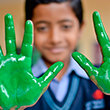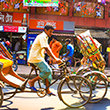
The bitterest pain among humans, the Greek historian Herodotus said, is to have much knowledge but no power. The truism has long been felt keenly in India, where 68 percent of the nation’s 1.2 billion people still live in rural areas, the majority of them on less than $1 a day.
Now, for the first time in India’s modern history, a bold social initiative offers hope for change: A leading entrepreneur and philanthropist is handpicking the brightest kids from rural, underprivileged communities and giving them a world-class boarding school education entirely free of cost. With the help of cutting-edge learning and development techniques, these children are being groomed as tomorrow’s global leaders.
VidyaGyan Leadership Academy (VidyaGyan means “wisdom through knowledge” in the Hindi language) is the brainchild of Shiv Nadar, founder and chairman of HCL Corporation, a $6.5 billion group of companies that includes India’s fourth-largest information technology firm.
Nadar, 70, is India’s seventh-richest person, with a personal fortune of $8.6 billion, according to Forbes India magazine. He launched VidyaGyan in 2009 through the eponymous Shiv Nadar Foundation, to which he has donated a billion dollars of his personal wealth over the past 20 years. Nadar created the charity in 1994 to provide high-quality education to children from impoverished backgrounds, and with the long-term goal of establishing models of sustainable development that can be replicated nationwide to help India bridge its formidable rural-urban divide.
VidyaGyan (pronounced vid·ya·gi·an) has two campuses, located in Sikandrabad and Sitapur, two nondescript cities 250 miles apart in Uttar Pradesh, one of the most underdeveloped of India’s 29 states. Bordering the national capital, New Delhi, Uttar Pradesh has 215 million people—more than the entire population of Brazil—and is an integral part of what journalists have long referred to as India’s cow belt, an immense rural area slightly larger than Texas where development has been sluggish and where the cow, which India’s majority Hindus consider holy, is particularly revered.
The idea behind the school, which runs from grades 6 to 12, is to create conscientious leaders for tomorrow’s world. Nadar hopes that VidyaGyan students will carry “the message of change to their communities, addressing problems like caste equality, girl child literacy and women’s health.”
Every year, VidyaGyan accepts 300 of the most exceptional fifth-graders from Uttar Pradesh. The entrance process is a highly competitive, mind-boggling exercise: Last year, 140,000 students applied to the school; 6,000 were shortlisted and tested for a variety of cognitive and other skills before being given a final entrance exam. In the end, just one of every 466 applicants got a spot at VidyaGyan.
Being a high achiever isn’t the only prerequisite, however. Applicants must also live and attend school in a rural area, and their family’s annual income cannot exceed $1,600, roughly half of what it costs Nadar’s charity to feed, clothe, teach and care for a single student at VidyaGyan every year. The annual average per capita income in Uttar Pradesh is $550.
Usually 9 or 10 years old when they first arrive, “these are students who have never touched a computer before, never seen Western-style toilets and have had zero exposure to urban areas,” explains Bishwajit Banerjee, principal of VidyaGyan’s Sikandrabad campus, where 1,012 students are currently housed. The Sitapur campus is home to 900 students, and plans are underway to boost VidyaGyan’s total student population to about 4,200 in coming years.

The Sikandrabad campus spans 30 acres in a village named Dulehra, about 50 miles east of New Delhi. Launching a leadership academy in an area known more for dairy production than data processing was deliberate. As Nadar explains on the school’s website: “VidyaGyan students straddle two extremities. On the one hand, they receive world-class education and exposure at par with their urban counterparts, and on the other, they witness the extreme deprivation of their families on multiple levels.”
Take Kanhiya Lal, a 14-year-old who lost his father—the sole breadwinner for his family of seven—at an early age. Lal’s elder brother supported the family and encouraged him to take the VidyaGyan entrance exam. Today, Lal is working hard to realize his dream of becoming a pilot—either in the prestigious Indian Air Force or with a commercial airline.
Or consider the remarkable transformation of Gulsanawwar Ali, 17, a VidyaGyan 12th-grader poised to be among the first academy graduates next year. Orphaned in infancy, Ali also was brought up by his elder brother, who drills agricultural wells for a living. In 2013, VidyaGyan sent the younger Ali to Ivy League Brown University in Providence, Rhode Island, for a two-week student exchange program. It piqued his interest in pursuing an undergraduate degree in international relations. Ali’s career dream: to work for world peace.
Like just about every one of his peers, Ali hadn’t heard a word of English before VidyaGyan. “Their level of English is almost zero when they come here,” says principal Banerjee, adding that it’s typically not until the ninth grade that students fully adjust to the school’s English mode of instruction, thereby becoming integrated with the world’s leading international language. Another reason students are taught in English, explains Banerjee, is that “the Hindi terminology in most subjects is very difficult.”
It’s an all-around challenge to educate and nurture young children who have been separated from their families for the first time and who have never been exposed to people—or even foods—from outside their village, says Banerjee, nor is it always easy for their families to let go. Occasionally, family members turn up on campus demanding to take a child home. “They give every possible excuse for the child’s return,” he says. “We have changed our mind; the child’s mother is missing him too much; the grandparents are upset; someone at home has fallen ill.”
But the relatives invariably relent, Banerjee explains, after a bit of reassurance and a reminder of the benefits of an education at VidyaGyan. “Most of the parents are illiterate and many who see their children after six months can hardly recognize them,” he says, adding: “Their cleaner environment and improved diet shows visibly on the children,” who are typically unaware, for example, that drinking water should be tasteless and colorless.
To inspire students, VidyaGyan routinely invites prominent and influential people to speak at the school. A special effort is made to include speakers who have achieved success in life despite humble roots.
“We all have to remember where we came from—and where we have to come back—to help people,” Richard Verma, the current U.S. ambassador to India and an ethnic Indian himself, told VidyaGyan students during a visit in May. “Once we get our education, it doesn’t mean you’re done. It means you now have to give back to your communities [and] families, who have sacrificed a lot so that you could be here.”
In an effort to develop its international ties, and to motivate students to pursue higher education overseas, VidyaGyan invites a yearly summer intern from Harvard University. This year’s intern was Sophia Chua-Rubenfeld, the daughter of Amy Chua, author of the bestselling 2011 cross-cultural book, Battle Hymn of the Tiger Mother.
In addition to daily instruction from a faculty of 85 teachers (the current student-teacher ratio at VidyaGyan is 12:1, which Banerjee soon expects to reduce to 10:1, then 8:1), students also expand their social horizons on field trips to thriving metropolises like New Delhi.
The school nurtures students’ ties to their home communities where they are looked upon as celebrities and serve as ambassadors of education. “When I go back home to my village,” says Manvi Choudhary, a VidyaGyan 11th-grader who spent her 10th-grade year in Minnesota as part of the Kennedy-Lugar Youth Exchange and Study Abroad program, “I am constantly asked how I got into VidyaGyan.”
Choudhary, whose father makes ends meet by farming two acres of land and working part-time at a local store, tells the children of her village that if they study hard, as she did, they can follow in her footsteps.
VidyaGyan’s meritorious nature is aptly reflected in its motto—Vidya Paramaishwaryam. The words, prominently displayed on a sign at the school’s entrance, mean ‘knowledge is the greatest wealth.’
The academy’s emblem—a red lotus—has a particularly interesting cultural history. Found throughout India, usually in murky water, the lotus is believed to have a divine origin in Hindu and Buddhist faiths. At VidyaGyan, the image of a blooming lotus graces students’ uniforms and is meant to metaphorically signify the ascent of purity and beauty from dirt.
For benefactor Shiv Nadar, creating VidyaGyan was a priority not only because he believes education is a transformative force in any society, but also because he owes his own success to education. Born and raised in the southern Indian state of Tamil Nadu, Nadar saw his first big city—the state capital Chennai—when he was 21 years old. He won a scholarship to study engineering at a college in his home state, which proved to be a seminal influence in his life. “Education is a multiplier,” Nadar told Forbes India this past January, after the magazine named him Outstanding Philanthropist of the Year for 2014. “In any educational institution we create, we continue the multiplication process for years to come.”
Besides VidyaGyan, Nadar has built two engineering colleges, a school of management and computer applications, a university, an art museum and a network of secondary schools in urban areas.
In all these endeavors, Nadar has proven far more socially responsible than the vast majority of India’s entrepreneurs, many of whom have only recently been nudged toward philanthropy by the Companies Act 2013, which mandates corporate social responsibility (CSR). It requires all companies incorporated in India and worth at least $83 million—or with an annual turnover of more than $160 million or an annual net profit of at least $830,000—to spend at least 2 percent of their average profits on CSR initiatives.
In 2014, Nadar launched his most ambitious social program yet. Called Samudhay, the initiative entails a partnership with the Uttar Pradesh government to develop 120 villages in the western region of the state where VidyaGyan’s Sikandrabad branch is located.
Nadar plans to use crowdsourcing to find and work with the best nongovernmental organizations to transform the adopted villages—and eventually villages in other states—in five key areas: education, employment, health, infrastructure and water. “This is the biggest project anyone has ever dared to do in our country,” Nadar told Forbes India earlier this year.
Helping Nadar realize his goals is his daughter and only child, Roshni, who serves as CEO and executive director of HCL Corporation, and is a trustee of the Shiv Nadar Foundation and VidyaGyan’s chairwoman. A former news producer for CNN America, Roshni, who turns 34 in September, is an alumnus of the Kellogg Graduate School of Management, where she studied social entrepreneurship.
Roshni believes that, for all their good works, entrepreneurs like her father can’t possibly bear the burden of improving education for all Indians. It’s a fair assertion, given that 37 percent of all illiterate adults worldwide are Indian, according to a 2014 United Nations report. What’s more, what qualifies as literacy in India is the mere ability to sign one’s name, and not the skill—so crucial in a globalized world—to constantly learn and relearn.
It’s that huge gap, coupled with the fact government-run schools in rural areas provide only the flimsiest of foundations for the lifelong pursuit of knowledge, that led the father and daughter team to focus on providing a well-rounded education to rural children in particular, who can be instant role models for their village peers. As Roshni put it in a 2014 newspaper article, “In our own humble way we are attempting to address the problem of leadership.”
In 2016, as the first batch of VidyaGyan graduates leave the academy’s Sikandrabad campus, Shiv Nadar’s dream of dispatching global ambassadors for his institution will become reality. The first graduating class is bound to attract media attention, and just might cause a buzz in certain halls of U.S. academia.
“Our vision is that one day if Harvard, Princeton or any great institution wants rural, meritorious, underprivileged but absolutely brilliant students in India, they should be coming to VidyaGyan,” Roshni Nadar said in a speech this summer at the school’s Sikandrabad branch. “We’re preparing our students for that journey—for life beyond VidyaGyan,” she said. “We are at the cusp of something really exciting.”

